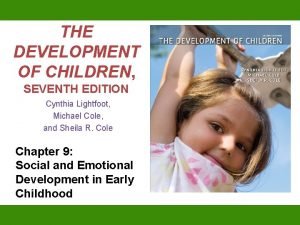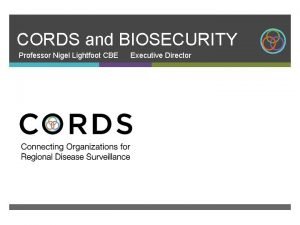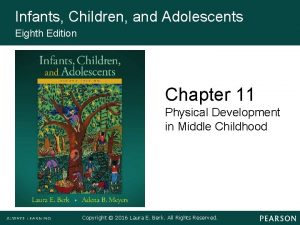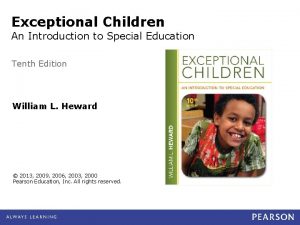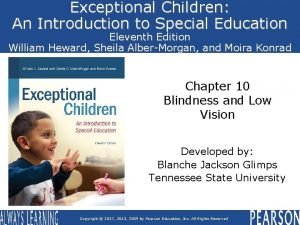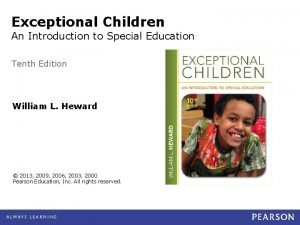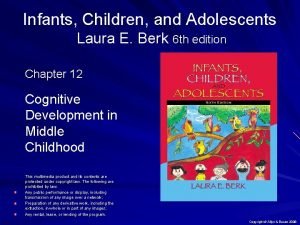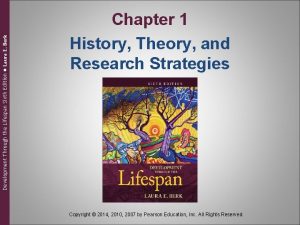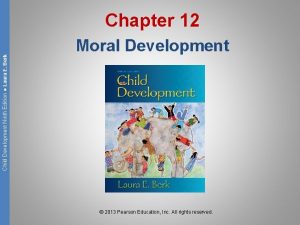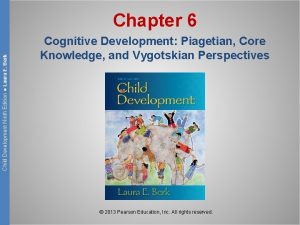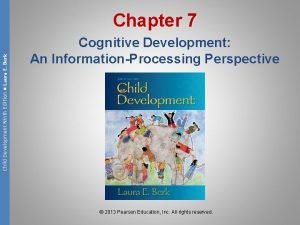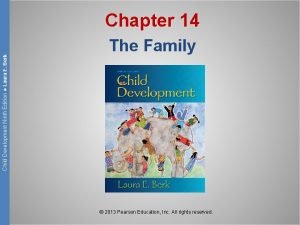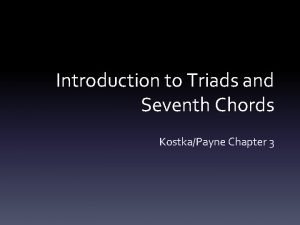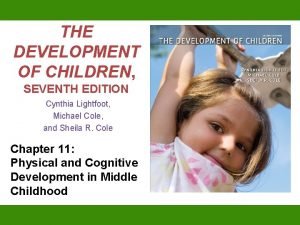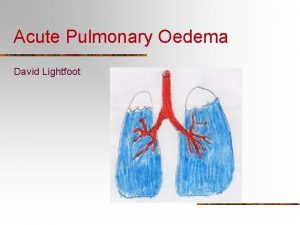THE DEVELOPMENT OF CHILDREN SEVENTH EDITION Cynthia Lightfoot








































- Slides: 40

THE DEVELOPMENT OF CHILDREN, SEVENTH EDITION Cynthia Lightfoot, Michael Cole, and Sheila R. Cole Chapter 15: Social and Emotional Development in Adolescence

Chapter Overview I. Emotional Development in Adolescence II. Relationships with Peers III. Sexual Relationships IV. Relationships with Parents V. Identity Development VI. Adolescent Health and Well-Being VII. Reconsidering Adolescence

I. Emotional Development in Adolescence • The experience of emotions • Regulating emotions

Regulating Emotions • Biological processes – Hormones – Frontal lobe

Regulating Emotions • Social processes – Parental warmth – Social expectations

I. Apply – Connect – Discuss • In general, girls are considered “more emotional” than boys. • Evaluate this belief in light of research on gender differences in emotional experience and emotion regulation.

II. Relationships with Peers • Major Changes – Time spent with peers increases – More time unsupervised – Increased size and diversity of groups – Increased intensity of friendships

Friendships • Friendship A close relationship between two individuals. • Reciprocity • Commitment • Equality • Important developmental functions – Intimacy – Autonomy

Gender Differences • Girls have more intense and intimate friendships than boys – Boys may be less intimate with friends because they are less trusting of their friends – Boys also more prone to homophobia – Girls less competitive – Girls focus more on communal goals

Cliques and Crowds • Cliques – Small, intimate peer groups – Serve emotional and security needs

Cliques and Crowds • Crowds – Larger groups – Provide opportunities to • meet people • develop romantic relationships • explore their social identity

Romantic Relationships • Central to sense of belonging and group status – Can feel neglected when friends start dating – Opportunity to share experiences with friends can enhance friendships • Cultural variations

Peer Pressure and Conformity • Homophily The degree to which friends are similar to each other in terms of behaviors, tastes, views, and goals. • Establishing homophily – Selection – Socialization

II. Apply – Connect – Discuss • How does Dunphy’s distinction between cliques and crowds fit your own adolescent experience of peer groups? • Reflect on the social structure of your high school and try to map out the different crowd types and the different cliques within them. • How do the concepts of homophily, selection, and socialization apply?

III. Sexual Relationships • Learning About Sex • The Sexual Debut

Learning About Sex • Learn sexuality from various sources – Parents, peers, media, and educational programs • Great Variability

Sexual Debut • Significant step from virginity to sexual activity • Cultural differences • Age varies • Gender differences

IV. Relationships with Parents • Conflicts • Continual influence

Conflicts • Issues – Responsibilities and privileges – Curfews – Athletics – Financial independence • Personal domain • Social conventional domain

Continuing Influence • Forms of influence – Shape types of interactions encountered – Styles of handling situations • Two patterns of family interactions – Constraining interactions – Enabling interactions

IV. Apply – Connect – Discuss • Your 16 -year-old daughter announces that she intends to leave home and school in order to join a spiritual community that encourages its member to “find themselves” by working toward the common good.

Apply – Connect – Discuss • As an informed and sensitive parent, you recognize this as an expression of developing autonomy but, for obvious reasons, believe it would be a terrible mistake for her to pursue such a plan at this point in her life.

Apply – Connect – Discuss • Keeping in mind the evidence presented in this section on effective parenting, write your daughter a letter about what you think of her plan.

V. Identity Development • The “I” and the “me” • Types of identity • Identity and Culture

The “I” and the “Me” • Me-self – Object-self – Including roles and relationships, possessions, and characteristics • I-self – Subject-self – Reflecting on and guiding the object self

Types of identity • Mature Identity – “true self” • Ethnic Identity • Sexual Identity

Mature Identity • Erikson – Identity versus role confusion • Formalized by Marcia – Exploration – Commitment

Ethnic Identity • Ethnic identity Individuals’ sense of themselves as a member of a particular ethnic group. • Ethnic minority youth

Sexual Identity • Sexual identity Individuals’ understanding of themselves as heterosexual, gay or lesbian, or bisexual. • Sexual minority youth Adolescents who develop identities as gay, lesbians, or bisexuals.

Identity and Culture • Independent sense of self – Orientation toward being unique, expressing personal thoughts, opinions, goals • Interdependent sense of self – Orientation toward fitting in, promoting the goals of others, “reading” others

V. Apply – Connect – Discuss • How does the distinction between an independent and an interdependent sense of self apply to your own sense of self?

VI. Adolescent Health and Well. Being • Emotional Health • Sexual Health • Positive Youth Development

Emotional Health • Problems that may emerge: – Internalizing problems • Ie. Depression and anxiety • More common among girls – Eternalizing problems • Ie. Aggression and delinquency • More common among boys

Depression • Most common psychological problem of adolescence • Risk factors: – Biological inheritance – Characteristics of the environment – Cultural values and stereotypes • Effective treatments – CBT

Eating Disorder • Girl’s negative body image • Examples: – Anorexia nervosa – Bulimia nervosa – EDNOS • Recovery is difficult

Positive Youth Development • Relatively new approach • Emphasize strengths and positive qualities

VI. Apply – Connect – Discuss • Your school board is once again seeking your assistance, this time to revamp its sex education program, which is considered outdated and out of touch with issues facing today’s youth. • The goal is to develop programs aimed at seventh-graders (12 -year-olds) and tenthgraders (15 -year-olds).

Apply – Connect – Discuss • Outline a general plan for each program. • What topics should each program include? • What “issues facing today’s youth” should be addressed? • Should boys and girls participate in the program together or separately?

Apply – Connect – Discuss • Explain how the program would take into account differences between 12 - and 15 year-olds.

VII. Reconsidering Adolescence • Purpose of a lengthy adolescence • Role of culture • Prolonged marriage education and delayed
 Cynthia lightfoot
Cynthia lightfoot Gordon lightfoot ethnicity
Gordon lightfoot ethnicity Endomysium
Endomysium Database system concepts seventh edition
Database system concepts seventh edition Principles of information security, 7th edition
Principles of information security, 7th edition Molecular biology of the cell seventh edition
Molecular biology of the cell seventh edition Biology seventh edition
Biology seventh edition Guy lightfoot
Guy lightfoot Guy lightfoot
Guy lightfoot Robert lightfoot tamu
Robert lightfoot tamu Joshua lightfoot
Joshua lightfoot Nigel lightfoot
Nigel lightfoot Infants and children 8th edition
Infants and children 8th edition Discontinuity of development
Discontinuity of development Exceptional children 10th edition
Exceptional children 10th edition Exceptional children 11th edition
Exceptional children 11th edition Exceptional children 10th edition
Exceptional children 10th edition Infants, children, and adolescents 8th edition
Infants, children, and adolescents 8th edition Infants and children 8th edition
Infants and children 8th edition Using mis 10th edition
Using mis 10th edition Using mis (10th edition) 10th edition
Using mis (10th edition) 10th edition Unit 18 assessing children's development support needs
Unit 18 assessing children's development support needs Week by week plans for documenting children's development
Week by week plans for documenting children's development Development through the lifespan 6th edition
Development through the lifespan 6th edition Laura e berk child development 9th edition pdf
Laura e berk child development 9th edition pdf Child development berk 9th edition
Child development berk 9th edition Transductive reasoning psychology
Transductive reasoning psychology Laura e berk child development (9th edition pdf)
Laura e berk child development (9th edition pdf) Child development ninth edition
Child development ninth edition Lifespan development third edition
Lifespan development third edition Lifespan development third edition
Lifespan development third edition The devil from seventh grade
The devil from seventh grade Theme of the seventh man
Theme of the seventh man You shall not steal. this commandment is number
You shall not steal. this commandment is number How many circles of hell are there in dante's inferno
How many circles of hell are there in dante's inferno Seventh-day adventist leadership structure
Seventh-day adventist leadership structure Introduction to triads and seventh chords
Introduction to triads and seventh chords Brave seventh grade viking warrior
Brave seventh grade viking warrior The seventh man characters
The seventh man characters Article 9 of the creed
Article 9 of the creed Mother and daughter by gary
Mother and daughter by gary

